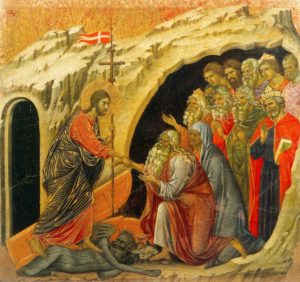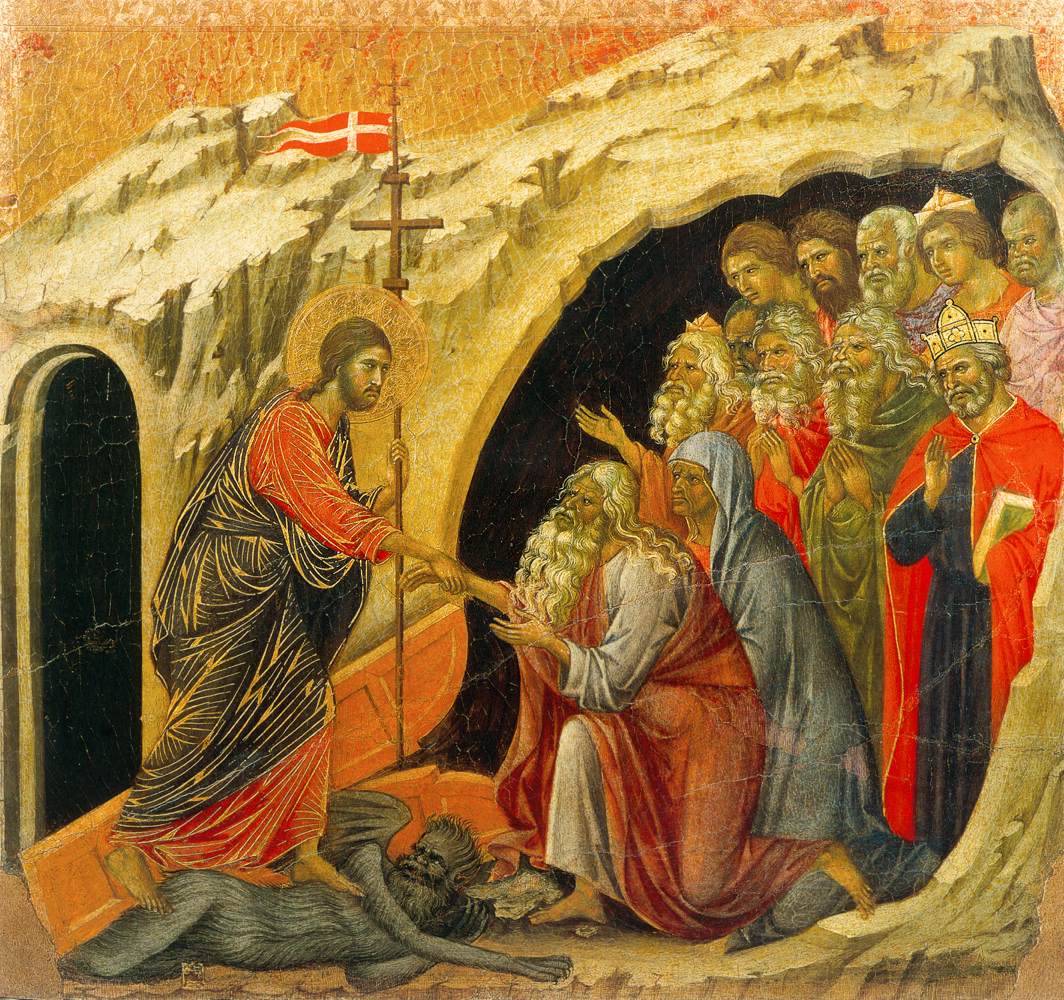
Where is Christ after He dies on Friday afternoon and before He rises on Easter Sunday? Both Scripture and Tradition answer this question. Consider the following excerpt from a second century sermon as well as this meditation from the Catechism of the Catholic Church.
Ancient Homily for Holy Saturday (ca. 2nd century A.D.):
Today a great silence reigns on earth, a great silence and a great stillness. A great silence because the King is asleep. The earth trembled and is still because God has fallen asleep in the flesh and he has raised up all who have slept ever since the world began. … He has gone to search for Adam, our first father, as for a lost sheep. Greatly desiring to visit those who live in darkness and in the shadow of death, he has gone to free from sorrow Adam in his bonds and Eve, captive with him—He who is both their God and the son of Eve. … “I am your God, who for your sake have become your Son. … I order you, O sleeper, to awake. I did not create you to be a prisoner in hell. Rise from the dead, for I am the life of the dead.”
Nothing could be more beautiful than that line addressed to Adam and Eve: “I am your God, who for your sake have become your Son.”
St Ephrem the Deacon also attests to this descent among the dead and describes it rather colorfully:
Death could not devour our Lord unless he possessed a body, neither could hell swallow him up unless he bore our flesh; and so he came in search of a chariot in which to ride to the underworld. This chariot was the body which he received from the Virgin; in it he invaded death’s fortress, broke open its strongroom and scattered all its treasure. (Sermo de Domino nostro, 3-4. 9: Opera edit. Lamy, 1, 152-158. 166-168)
Scripture also testifies to Christ’s descent to the dead and what He did: For Christ also suffered once for sins, the righteous for the unrighteous, that he might bring us to God, being put to death in the flesh but made alive in the spirit, in which he went and proclaimed to the spirits in prison. … For this is why the gospel was preached even to those who are dead, that though judged in the flesh the way people are, they might live in the spirit the way God does (1 Peter 3:18; 1 Peter 4:6).
The Catechism of the Catholic Church on Christ’s descent to the dead (excerpts from CCC # 632-635):
[The] first meaning given in the apostolic preaching to Christ’s descent into hell [is] that Jesus, like all men, experienced death and in his soul joined the others in the realm of the dead.
But he descended there as Savior, proclaiming the Good News to the spirits imprisoned there [cf. 1 Pet 3:18-19]. Scripture calls the abode of the dead, to which the dead Christ went down, “hell”—Sheol in Hebrew, or Hades in Greek—because those who are there are deprived of the vision of God [cf. Phil 2:10; Acts 2:24; Rev 1:18; Eph 4:9; Pss 6:6; 88:11-13].
Such is the case for all the dead, whether evil or righteous, while they await the Redeemer [cf. Ps 89:49; 1 Sam 28:19; Ezek 32:17-32; Luke 16:22-26]. “It is precisely these holy souls, who awaited their Savior … whom Christ the Lord delivered when he descended into hell” [Roman Catechism I, 6, 3].
Jesus did not descend into hell to deliver the damned, nor to destroy the hell of damnation, but to free the just who had gone before him.
[So] the gospel was preached even to the dead. The descent into hell brings the Gospel message of salvation to complete fulfillment. This is the last phase of Jesus’ messianic mission, a phase which is condensed in time but vast in its real significance: the spread of Christ’s redemptive work to all men of all times and all places, for all who are saved have been made sharers in the redemption.
Christ went down into the depths of death so that “the dead will hear the voice of the Son of God, and those who hear will live” [1 Peter 4:6]. Jesus, “the Author of life”, by dying, destroyed “him who has the power of death, that is, the devil, and [delivered] all those who through fear of death were subject to lifelong bondage” [Heb 2:14-15; cf. Acts 3:15].
Henceforth the risen Christ holds “the keys of Death and Hades”, so that “at the name of Jesus every knee should bow, in heaven and on earth and under the earth” [Rev 1:18; Phil 2:10].
Here is a recording of a sermon I preached on this topic: Where is Jesus Now.


In the quietness, silence, tranquility and sadness, out of grieving to the death of the
This Human Person in the flesh of the Author of Life, we await in great expectation HIS rising from the dead. Let us wallow yet in grief to what we have done to HIM Whom we crucified and feel the emptiness within us. We have perpetrated the greatest of crime to This MAN-GOD Who had done no wrong whatsoever to HIS Creation. Yes, HE Loved us to the end, to HIS very last breath, freely giving the only earthly Life HE can bequeath, that we can appreciate and acknowledge HIS Words ‘Greater Love hath no man than this, that a man gives his life for his friend.’ Even in HIS death, HE works. HE works to bring out of darkness those who await their redemption in Sheol. Thus HIS one entry into time transcends time, space and perceptions bringing forth redemption before, during and after HIS Passion. If we cannot understand that there is GOD because of what had transpired, I do not know what else will.
Monsignor, we owe a great debt to you for the reflections on these Holy Triduum, Holy Week. It had enriched our faith and we pray blessings upon blessings unto you. Now, we greet you A Truly Joyful Resurrection Day to you and your readers.
If evil souls are annihilated and there is no hell, how can there be freedom? Doesn’t that idea that is currently circulating contradict Scripture?
Our souls are immortal; that’s what distinguishes us from the animals. So our souls will go on either in Heaven or Hell (Purgatory for now) and so “yes, Virginia there is a Hell.” Our Lord speaks of it many times in Scripture. He died on the Cross to redeem us from Hell. So anyone who says otherwise is a false shepherd.
Of course, His Body remained in the Tomb; it was His Soul that harrowed hell. A human being, including the One True Man, is body and soul together; I only say this because there is a widespread error that that the soul is “the real person” and the body is “an empty shell”. (This notion that body and soul have no real relationship to each other is, among other things, central to the transsexual movement.) The Soul of Jesus remained united with His Divinity, but so did His Body — a fact that I never even considered as a Protestant.
My last sentence was awkward. I meant His Soul remained united to His Divinity, and His Divinity also remained united to His Body, though His Body and Soul were separated by death.
Be careful, Howard, about calling Jesus a “human being” … he is a Divine Person with two natures, human and divine.
JT, the Church says that Jesus is True God AND True Man. This was clearly reflected in what I wrote. If you did not understand that, it is on you. More seriously, if you think the Body of Christ is a mere disposable shell, as many people think today, you are in serious error. Likewise, if you think the Body of Christ was something other than a human body, you are in serious error. Because the Body of Christ is remains an integral part of Christ’s humanity, and therefore His Person, even in death — remaining united with His Divinity — the question of “where was Jesus between His death and resurrection” becomes more complicated.
According to “The Mystical City of God”
after dying on the cross,
Jesus descended into Limbo.
Hey, why was my comment not posted?
Do you have a problem with the biography of the Mother of God?